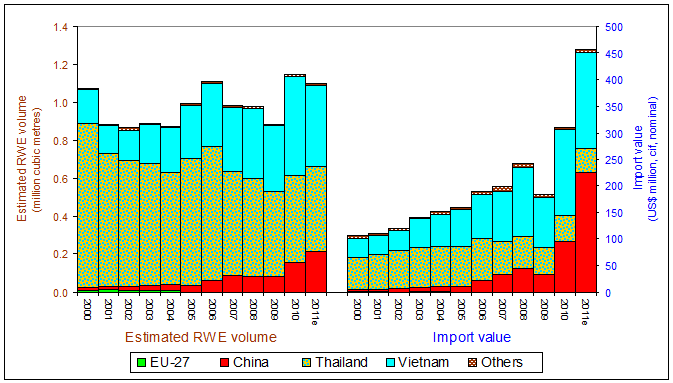|
|
||
|
Laos Sawn wood comprises the great majority of the timber which Laos exports. During the early years of last decade, China's imports of veneer and plywood were substantial. Chart 1 - Trade in timber from Laos{Footnote
1} Chart 1 shows that Thailand, Vietnam and, to a lesser extent China account for almost all the timber which is exported from Laos. Imports by Vietnam increased strongly during the middle years of last decade. Imports by China (of both logs and sawn wood) tended to rise throughout the decade and most entered China overland for importers located in Simao and Xishuangbanna.{Footnote 2} Much of the quantity exported to China is said to be forest in the north of Laos which is being cleared for commercial agriculture - particularly rubber plantations.[section 4.3][third ¶, p9] Access to timber is the primary motivation for some who "invest" in such agriculture.[penultimate ¶ and footnote 39, p89] These "developments" have tended to have serious negative consequences - not least for China, which has promoted them as providing local alternatives to opium cultivation.[*] Some have involved the Laos military, and the Laos military has logging interests elsewhere.[third ¶ and seventh ¶, p1] An extensive literature[*] - particularly concerning Laos [second ¶, p17][*]- provides evidence that commercial agriculture projects tend to be land grabs, impoverish forest peoples, and provoke instability. The export of logs, sawn wood and "semi-finished products" from forest in Laos is prohibited.[*][p4 & p5] However, assessing compliance with the letter of the law is hampered by loopholes[penultimate ¶, p8] and, in practice, formal government endorsement over-rides the law.[final ¶, p20] Timber from trees felled on land which is to be submerged by reservoirs may be exported. Exporters take advantage of the difficulty of assessing the provenance of timber which is (fraudulently) documented as deriving from such land. During 2006/7, the amount of timber imported from Laos was roughly 60% greater than official statistics for "production" (the latter being 650,000 cubic metres, of which c.80% was supposedly from land designated for infrastructure projects).[Tables 2 and 3] Clearance for commercial agriculture should not generate large quantities of timber given that it is only permitted on bare land or severely degraded forest land. However, the latter has not been defined.[penultimate ¶, p16] Whereas most of the timber exported to China is likely to enter end-use in China, much of that exported to Thailand and Vietnam is likely to be exported subsequent to milling - primarily as furniture (notably garden furniture), mouldings and joinery.[*] Most of the timber which Vietnam imports from Laos is logged by entities linked to the Vietnamese military and wealthy Lao.[p18-p13] Much of that logging takes place in forest designated for protection. Roughly 40% of the export value of this timber is attributable to corruption in the allocation of quotas for logging - slightly more than half to senior officials.[second ¶, p4] ExposÚs during 2008 and 2011, indicate that neither of the two governments nor the Vietnamese furniture industry (its primary customer) has tried to halt this illicit trade.[final ¶, p1] Conclusion: All exports of logs and sawn wood from Laos are prohibited - except those genuinely from major infrastructure projects (which probably account for a minority of the total). China, Thailand, Vietnam and increasingly China account for almost all those exports.{Footnote 3} Footnote 1: Source: importing countries as per [footnote 1]. (Laos does not seem to publish statistics of its bilateral trade.) Note: Vietnam has not yet published its 2010 trade statistics; roundwood equivalent ("RWE") volume for Vietnam's imports has been estimated notionally from import value. Footnote 2: Based on monthly statistics published by General Administration of Customs of the People's Republic of China Footnote 3: If 40% of the total exported derived from infrastructure clearance, the roundwood equivalent volume and import value of illegal timber imported from Laos during 2010 would have been 600,000 cubic metres and US$150 million. |
||
|
|
||

